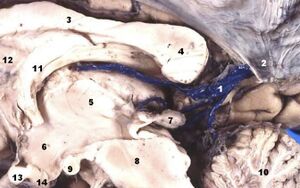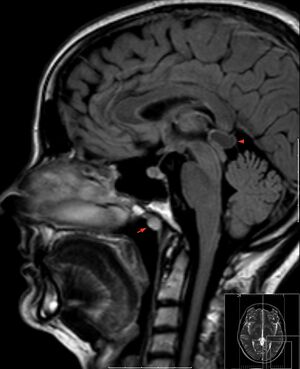Pineal gland
Pineal gland (epiphysis cerebri, corpus pineale) is up to 1 cm long and at the widest point 3–5 mm wide conical unpaired body, weighing about 120 mg. It forms the largest part of the diencephalic structure called the 'epithalamus' . The pineal gland is attached to the "commissura habenularum", but caudally extends between the mesencephalic "colliculi superiores". Functionally, it is an endocrine gland.
Development[edit | edit source]
The pineal gland is formed as a protrusion by the proliferation of ependymal cells in the posterior part of the ceiling plate of the diencephalon around 7. week (in the front part, the cells of the ceiling plate participate in the formation of tela choroidea venticuli tertii). During this period, mesenchyme also grows into the foundations of the future pineal gland. Around 14. weeks or later, the empty space in the original base is filled and the cells differentiate into characteristic elements.
Structure[edit | edit source]
On the surface of the pineal gland is a weak fibrous sheath adjacent to pia mater (capsula corporis pinealis). From it, thin fibrous septa penetrate into the body of the pineal gland, dividing the organ into irregular, incomplete lobes formed by beams. Along the septum, vessels and unmyelinated nerve fibers enter the pineal gland. Epiphyseal cells can be divided into two groups:
- pinealocytes (pinealocyti cardinales),
- interstitial neuroglial cells of the type astrocytes (gliocyti pineales).
Pinealocytes predominate.
Pinealocytes are highly modified neurons arranged in beams between which fenestrated capillaries run. They are star-shaped and emit numerous cytoplasmic protrusions with dilated club-shaped ends near the vessels. Small electron-density granules are concentrated in these dilatations. Pinealocytes are producers of melatonin, a derivative of serotonin.
Interstitial glial cells have nuclei almost rod-shaped, much more stainable (with a higher content of heterochromatin). When observed under a light microscope, it is sometimes possible to observe their stronger cytoplasmic projections.
Numerous unmyelinated axons end between the pinealocytes. Their endings sometimes have the character of special synapses. A large number of vesicles with norepinephrine can be found here, and serotonin has also been demonstrated.
Typical of the pineal gland are often calcified lamellar stones, so-called brain sand ( acervulus cerebri ). The stones have an irregular shape and are made of a substance of unknown protein origin. When stained with hematoxylin-eosin, they turn red. Soon, mainly on the periphery of often composed stones, Ca 2+ salts, mainly hydroxyapatite and calcium carbonate, are deposited. Such stones then acquire a purple to blue tinge.
Changes during life[edit | edit source]
The number of cerebral sand grains increases with age, so while during the first ten years of life we can find them in about 12% of the pineal glands, in the elderly it is already 70-80%. Since puberty, there have been degenerative changes in the pineal gland. Not only more concretions appear, but also more ligaments originating from sept. The melatonin-producing parenchyma decreases, and so the age of melatonin decreases with age. For older people, this is only a quarter of the value measured at a young age.
Function[edit | edit source]
The pineal gland is a producer of melatonin, which is involved in the regulation of circadian rhythms. Melatonin acts as a specific hormone, but at the same time affects and modulates the function of many endocrine glands. It affects the rhythmic function of the gonads and pituitary gland (positively affects the production of growth hormone and growth factors). Melatonin secretion fluctuates over 24 hours as it is attenuated by light. Epiphyseal tumors are associated with premature adolescence (pubertas praecox) and gonadal hypertrophy in pediatric patients.
Phylogenesis[edit | edit source]
Today's human pineal gland evolved from the third parietal eye of millions of years ago living reptiles. In today's reptiles (in some such as New Zealand hatteria) it has a light-emitting function and in amphibians melatonin is a very effective regulator of pigmentation (by clustering melanin granules in melanocytes, a lighter skin tone can be achieved).
Links[edit | edit source]
Related articles[edit | edit source]
- Epithalamus
- Diencephalon
- Circadian rhythm
- Endocrine organs
- Waking and sleeping
- Diseases of the pineal gland


